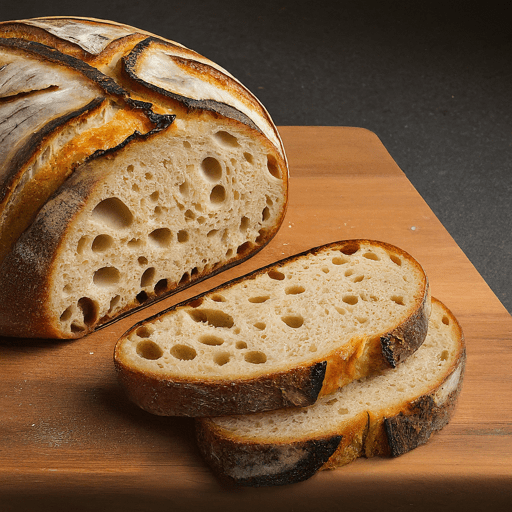Sourdough bread, with its tantalizing aroma and unique tangy taste, has captivated palates and hearts around the globe. But have you ever paused to ponder what marvels of chemistry are at play behind those crusty loaves? The process of crafting sourdough is not just a culinary art but a fascinating scientific adventure. This article peels back the layers of this ancient technique to reveal the incredible chemistry that transforms simple ingredients into a mouthwatering masterpiece. Prepare to embark on a journey through the microscopic world of fermentation, gluten networks, and acid-base reactions that make sourdough a delicious enigma.
The Magic of Fermentation
The Wild Yeast Wonders
The journey of making sourdough starts with its heart – the starter. This symbiotic culture of wild yeast and lactic acid bacteria is where chemistry begins its magic. Unlike commercial yeast, wild yeast thrives in a complex environment, fermenting the dough by consuming sugars and releasing carbon dioxide. This not only causes the dough to rise but also imparts sourdough’s characteristic tangy flavor.
Lactic Acid Bacteria: The Flavor Makers
Lactic acid bacteria (LAB) play a pivotal role alongside wild yeast. They ferment the sugars that yeast cannot, producing lactic and acetic acid. These acids are crucial for the distinctive taste of sourdough, contributing to its sourness and complex flavor profile. Furthermore, LAB’s activity strengthens the dough by influencing its pH, making it less hospitable to unwanted microbes.
A Balancing Act
The balance between yeast and LAB is delicate. Temperature, hydration, and flour type all affect their populations and activity. Mastering sourdough means understanding how to manipulate these variables to encourage the right balance between rising power and flavor development. It’s a testament to how slight chemical adjustments can result in dramatically different outcomes.
The Role of Time
Time is an often underestimated ingredient in sourdough chemistry. Longer fermentation periods allow for increased enzymatic activity, breaking down starches into simpler sugars for yeast and bacteria to consume. This not only enhances flavor but also improves texture and shelf life, showcasing the complexity involved in this seemingly simple process.
The Science of Gluten Networks
Building Strength
At the core of sourdough’s texture is gluten—formed from proteins present in wheat flour. When water is added to flour, glutenin and gliadin proteins intertwine to form gluten networks. These networks trap gases released during fermentation, allowing the dough to rise and develop structure.
The Impact of Hydration
Hydration plays a crucial role in developing gluten structure. Higher water content makes the dough more extensible and capable of trapping more gas, which results in a lighter, airier bread. However, too much water can weaken the gluten network, demonstrating the need for precision in baking.
Kneading: Developing Elasticity
Kneading the dough isn’t just physical labor—it’s a chemical process that aligns and strengthens gluten strands. Proper kneading ensures that the dough is elastic enough to stretch without tearing, creating the perfect conditions for gas retention and bread rise.
Autolyse: The Secret Weapon
Autolyse, a rest period after mixing flour and water, allows enzymes in the flour to break down proteins and starches. This step enhances gluten formation without additional kneading, leading to better texture and flavor in the final loaf—a prime example of how understanding chemical processes can elevate baking techniques.
Acid-Base Reactions: Shaping Taste and Texture
pH and Flavor
The pH level in sourdough impacts both taste and texture significantly. Lactic acid contributes to a more mellow sourness compared to acetic acid’s sharper tang. Manipulating fermentation conditions can alter these acid profiles, providing bakers with control over the bread’s flavor nuances.
Enzymatic Activity Unleashed
Enzymes within the dough become more active under certain pH conditions, affecting starches and proteins in transformative ways. This activity influences not just flavor but also how well the bread rises and its overall texture—showcasing the interconnectedness of chemical reactions in baking.
Dough Conditioning Naturally
Acidic environments condition the dough, strengthening gluten networks but also making them more extensible. This natural conditioning process can be seen as a balancing act where too much acidity can lead to overly tight or too slack doughs—a delicate equilibrium governed by chemistry.
Preserving Freshness
Finally, the acidic nature of sourdough acts as a natural preservative, slowing down starch retrogradation (staling). This chemical attribute explains why sourdough bread maintains its freshness longer compared to its non-sourdough counterparts—an added bonus to its delicious taste.
Conclusion
The art of sourdough baking is deeply intertwined with the science of chemistry. From fermentation to gluten development and acid-base reactions, every step in making sourdough involves complex chemical processes that contribute to its unique characteristics in flavor, texture, and longevity. Understanding these underlying principles not only demystifies sourdough but also opens up avenues for experimentation and mastery in baking. Indeed, every loaf of sourdough is a testament to the fascinating world of chemistry hidden within our kitchens.
